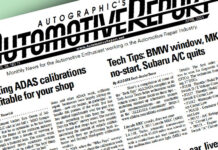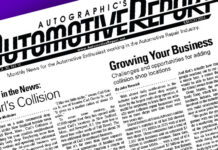By John Yoswick
There is no shortage of industry trends that can seem discouraging for independent collision repair businesses, from the growth of large collision repair chains, the increased implementation of crash avoidance technology, and the seeming lack of interest among young people in car-ownership and driving.
But there’s also a fair amount of heartening news for such shops in some recent data and projections that make the future of the industry appear significantly less bleak.
Less competition from dealers
Independent shops, for example, aren’t having to compete with a growing number of dealership body shops. Data from the National Automotive Dealers Association indicates the number of dealership body shops peaked in 2006 at nearly 8,700. Not surprisingly, the recession took a major toll on the dealership population, and by 2010, NADA estimates there were fewer than 5,900 dealership body shops. That has rebounded slightly, with NADA pegging the number fairly steady at about 6,400 from 2011 onward, but that’s still down more than 26 percent from the total a decade ago.
Independent collision shops also increasingly have opportunities to get automaker endorsements — through OEM shop certification programs — that in the past were reserved almost exclusively for dealership shops. Although legal and franchise requirements limit the use of the automaker name or logo by non-dealerships, all of the companies have created specific signage and logos that certified shops can use to let consumers know they have earned OEM certification.
Collision-avoidance technology not all-bad
Speaking at an international collision repair event earlier this year, Neale Phillips, of the European research firm Thatcham, said collision-avoidance technology and even autonomous vehicles are not likely to spell doom-and-gloom for collision repairers. Phillips said such technology is likely to curtail the severity of accidents, but vehicles in the worst accidents are usually declared total losses and not repaired anyway. So the technology might help keep more of what would have otherwise been “train wrecks” in shops rather than in the total loss category.
In his presentation at the International Body Shop Industry Symposium, Phillips is quoted as saying the technology also offers new opportunities for shops trained and equipped to recalibrate and retest sensors and other electronic components of the systems.
And despite all the hype about the Google car and other such technology, fully-autonomous vehicles aren’t likely to become commonplace for quite some time, according to projections released earlier this year by consulting firm McKinsey & Company.
Based on that firm’s research, commercial introduction of conditionally-autonomous vehicles — those which allow the driver to take occasional control — won’t begin before 2020 and perhaps not even for five to seven years further out.
Fully-autonomous vehicles won’t be sold before 2025, McKinsey predicts —and maybe not until after 2030. Only in its most optimistic “high-disruption scenario” does McKinsey project fully-autonomous vehicles accounting for even just 15 percent of new-car sales before 2030.
Agency projects growth in employee count
The Department of Labor (DOL) is also bullish on the growth of employment in the collision repair industry over the coming decade. In its latest projections released earlier this year, the DOL estimates that the total number of “automotive body and related repairers” working in the United States will grow 9.2 percent from 149,700 in 2014 to 163,500 technicians by 2024.
The DOL breaks out the current and projected employment demand by industries, with 79.3 percent of all body repairers accounted for by traditional autobody and glass shops and car dealers. The government figures also include self-employed autobody workers, which currently make up 6.8 percent of all working body techs. (The remaining 13.9 percent are employed in more than 25 other industries such as mechanical shops, car racing, parts vendors, limousine companies, trucking fleets and colleges.)
There was good news for the industry in even the shorter-term data in the latest DOL numbers. That report shows that the autobody and glass repair industry increased the number of working technicians by 1.1 percent since the last projection was published for the year 2012. That means the industry added about 500 technicians in each of those two years. Looking ahead, the DOL sees even faster growth, an increase of 760 technicians per year over the next decade.
More of that growth is expected to be enjoyed by shops than technicians going out on their own, the DOL projects. The DOL reported a dramatic drop of 6,600 self-employed body technicians from 2012 to 2014, a decline of 39 percent. That has lead the DOL to now project that the number of self-employed technicians will remain between 10,000 and 11,000 until 2024.
Technician jobs aren’t the only category of worker in the collision repair industry where the DOL foresees growth. The agency believes the total number of people working in the industry — including estimators, bookkeepers and managers — will grow 18.9 percent over the next decade. That will take the industry from 252,000 total employees in 2014 to more than 271,000 employees by 2024. That’s an average increase of 1,900 new jobs in the industry per year.
New-car sales and leasing looking strong
There are also several other trends that also bode well for collision repairers even in the short-term. First, new car sales are always good news for collision repairers because those cars tend to be insured — and thus more likely to be repaired after a collision — while they are leased or financed. They also have higher value so are less likely to become total losses. New-car sales hit 17.4 million last year, up 5.8 percent from 2014. The National Automotive Dealers Association is projecting another 2 percent increase this year, and that the total number of new-car sales will hit 18 million in 2017.
For those new vehicles being purchased, the average loan term has risen to 67 months. And the percentage of new-cars being leased, which dropped to 16.3 percent in 2009, has rebounded strongly, hitting 28.7 percent last year. Leased cars are even more likely to be repaired than those still under finance.
Used vehicle values holding their own
Strong new-car sales can sometimes lead to a glut of used cars, driving down the value of those cars; that in turn can push more wrecks into the total loss category. But so far, that isn’t happening. Used-car values rose strongly from 2009 until early 2011, and have bounced up and down modestly since then, hitting their most recent peak last December. They fell slightly in January of this year, but that was only the second decline in the previous eight months, and they remain relatively strong historically. So even if they soften somewhat this year, as expected, it isn’t expected to lead to much of a spike in total losses.
Survey data showing you’re not ‘the only one’
Some recently-released survey data also should serve as good news for the industry: If you’ve had an insurer tell you, “We don’t pay for that in your area,” for a particular repair procedure, that statement may not be entirely based on fact.
A series of four different “Who Pays for What?” surveys have asked shops how regularly they are paid by each of the eight largest auto insurers for nearly 100 different “not-included” operations, such as “feather, prime and block,” “remove coatings from pinch-welds,” and “mask for priming.” There are few if any of these procedures for which each of the insurers isn’t paying at least some shops in every region of the country.
The surveys have drawn responses from an average of more 700 shops each time. One finding that may be a surprise: DRP shops are paid, overall, more frequently for “not-included” estimate items than are non-DRP shops. Combining the results of all 29 “not-included” items in one of the surveys, for example, 62 percent of the DRP shops said they are paid “always” or “most of the time” for those estimate line items, compared to 52 percent of non-DRP shops.
Of the eight insurers included in that survey, State Farm and Farmers were the two with the most inconsistent reimbursement polices between DRP and non-DRP jobs. A DRP facility for State Farm or Farmers is nearly 15 percent more likely to be paid “always” or “most of the time” for the estimate items asked about in one of the surveys than a non-DRP facility for the same repair operations. Only one insurer in that particularl survey, Progressive, was actually less likely to pay one of its DRP shops for a “not-included” item than a non-DRP facility. Overall, Progressive was also the insurer least-likely to pay for any of the items in the survey whether or not the shop is part of its DRP.
The “Who Pays for What?” survey from earlier this year that focused on refinish operations found that one-third of shops believe that the top eight insurers “never” pay for the extra time it takes to “denib” or “finish sand and buff” a freshly-painted vehicle.
“Not true,” said Mike Anderson of Collision Advice, who conducts the surveys along with CRASH Network. “Other shops report being paid by the top-eight insurers for these operations.”
In fact, the survey showed that a third of shops are routinely paid for these operations. On a national basis, across all insurers, 39 percent of shops that bill for denib are paid “always” or “most of the time,” while 31 percent are paid “always” or “most of the time” for “finish-sand-and -buff.”
Although the percentages vary by insurer, results show that more than half (51.6 percent) of shops report that State Farm pays “always” or “most of the time” for denib when it is necessary. Even Progressive Insurance, which showed the lowest payment frequencies among the top eight insurers, pays for denib most, if not all, of the time according to 32 percent of shops.
Anderson notes that it is important to understand the difference between denib and finish-sand-and-buff in order to charge the appropriate labor time based on what was done to the vehicle. All three estimating system providers allow 30 percent of basecoat time for finish-sand-and-buff, which is lightly sanding all or most of a newly-painted panel and then polishing the panel back to gloss. To denib, however is to use a small sanding disk to remove dust specks on a newly painted panel followed by polishing of the same very small area. It has a different formula (or none at all) in each of the estimating systems, so the labor allowance varies significantly between finish-sand-and-buff and denib.
The survey results also reveal just how often these operations are required.
“In fact, over a quarter of all shops surveyed (28.5 percent) say they perform these procedures on 100 percent of the cars they paint,” Anderson pointed out. “And another 41 percent say that at least three-quarters of the cars they paint require at least one of these procedures.”
Reports including results and analysis for each of the four surveys (conducted one per quarter) are available at www.crashnetwork.com/collisionadvice.
The American driver is back!
Perhaps the most important positive trend for collision repairers is that Americans are driving again. The Federal Highway Administration reported a 4.2 percent increase in the number of miles traveled this past December (the latest month for which data has been released) over the preceding December. The total was, in fact, the highest ever recorded for December in any previous year.
And that wasn’t a one-month blip; for 2015 as a whole, driving totaled 3.15 trillion miles, up 3.5 percent from the previous 12 months.
With gasoline prices dropping still further since then and expected to stay low throughout 2016, vehicle travel — and the number of collisions that result — should rise this year, adding to the potential good news — both short- and long-term — for the collision repair industry. •
John Yoswick, a freelance writer based in Portland, Ore., who has been writing about the automotive industry since 1988, is also the editor of the weekly CRASH Network (for more state-by-state numbers or a free 4-week trial subscription, visit www.CrashNetwork.com). He can be contacted by email at jyoswick@SpiritOne.com.



